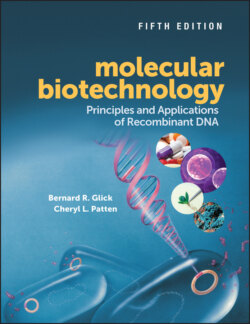Читать книгу Molecular Biotechnology - Bernard R. Glick - Страница 7
На сайте Литреса книга снята с продажи.
ОглавлениеPreface to the Fifth Edition
BASED ON THE DEVELOPMENT OF RECOMBINANT DNA technology, molecular biotechnology emerged as a new research discipline in the late 1970’s. Since those early days, there has been a veritable explosion of knowledge in the biological sciences. With the advent of PCR, chemical DNA synthesis, DNA sequencing, monoclonal antibodies, directed mutagenesis, genomics, proteomics, metabolomics, and more recently, specific genome modification techniques, our understanding of and ability to manipulate the biological world has grown exponentially. When the first edition of Molecular Biotechnology: Principles and Applications of Recombinant DNA was published in 1994, nearly all of the transgenic organisms that were produced included only a single introduced gene. Now, 23 years later it is common for researchers to engineer organisms by both modifying the activity and the regulation of existing genes and also by introducing entire new pathways. In 1994, only a handful of products produced by this new technology had been commercialized. Today, as a consequence of molecular biotechnology hundreds of new therapeutic agents are available in the marketplace with many more in the pipeline as well as dozens of transgenic plants. DNA technologies have become a cornerstone of modern forensics, paternity testing and ancestry determination. A number of new recombinant vaccines have been developed, with many more on the horizon. The list goes on and on. Molecular biotechnology has clearly lived up to its promise and all of the original hype that has existed since the late 1970s. Worldwide there are several thousand biotechnology companies, in virtually every corner of the globe, employing hundreds of thousands of scientists. When the exciting science being done at universities, government labs and research institutes around the world is factored in, the rate of change and of discovery in the biological sciences is absolutely astounding. This fifth edition of Molecular Biotechnology, building upon the fundamentals that were established in the previous four editions, endeavors to provide readers with a window on some of the major developments in this growing field. Given the enormity of the field of molecular biotechnology, we have had to be highly selective in the material we included in this edition. Moreover, the window that we are looking through is moving. This notwithstanding, we both expect and look forward to the commercialization of many of the discoveries that are discussed here, and in the future to the development of many new approaches, insights, and discoveries.
We have throughout endeavored to make the text reader friendly by minimizing the use of technical jargon and unnecessary abbreviations. Moreover, when an important term appears for the first time in the text, it is followed in parentheses with a synonym or brief explanation. The overall size of this edition has been pared down significantly compared to the fourth edition, done, in large measure, by removing some older material that has come to be common knowledge within the past 10–20 years. In addition, to facilitate the book’s flow and ease of understanding, in a number of instances, two or more figures have been combined into a single figure. Endeavoring to be as up-to-date as possible, this edition expands the discussion of interfering RNA and explains CRISPR technology in detail, providing examples of their use in both gene therapy and transgenic plants.
Each chapter opens with an outline of topics and concludes with a summary and list of review questions to sharpen students’ critical thinking skills. All of the key ideas in the book are illustrated by the more than 500 full-color figures and elaborated in more than 80 tables. After introducing molecular biotechnology as a scientific and economic venture in Chapter 1, the next two chapters explain the detailed methodologies of molecular biotechnology. These chapters provide a solid scientific base for the remainder of the book. Chapters 4 to 8 present examples of microbial molecular biotechnology covering such topics as the production of metabolites, new vaccines, both protein and nucleic acid therapeutic agents, diagnostics, bioremediation, and biomass utilization. Chapter 9 describes some of the key components of large-scale fermentation processes using recombinant microorganisms. Chapters 10 to 12 describe the molecular biotechnology of plants and animals. The book concludes in Chapter 13 with a discussion of the interaction of molecular biotechnology with society including controversies that have occurred as a consequence of this technology, coverage of the regulation of molecular biotechnology and patents.
Throughout the text we have relied extensively upon the recent published work of many researchers. In all cases, although not cited directly in the body of a chapter, the original published articles are cited in the references section of the appropriate chapter. In some cases, we have taken “pedagogic license” and either extracted or reformulated data from the original publications. Clearly, we are responsible for any distortions or misrepresentations from these simplifications, although we hope that none has occurred. The references sections also contain other sources that we used in a general way, which might, if consulted, bring the readers closer to a particular subject.
BERNARD R. GLICK
CHERYL L. PATTEN
